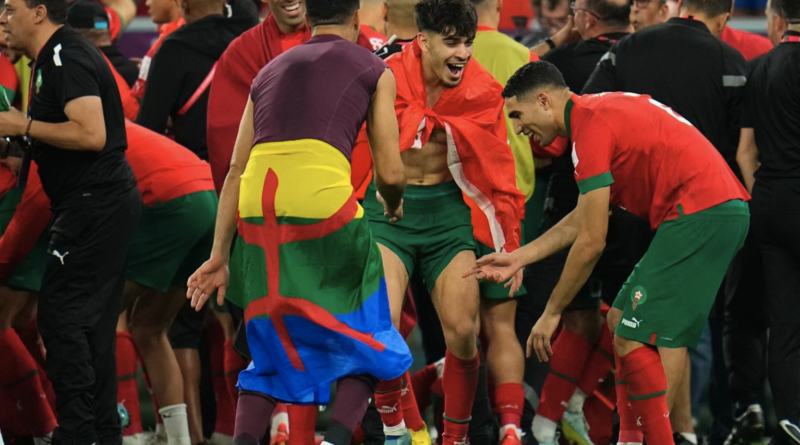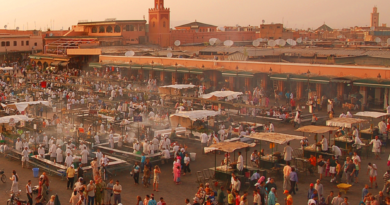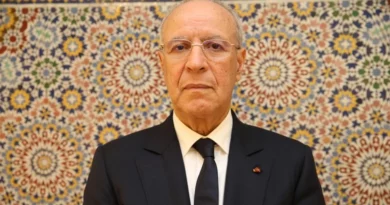Morocco’s World Cup Run Was a Game Changer
By Hisham Aïdi*
Morocco’s run in this World Cup was exhilarating. Led by Paris-born coach Walid Regragui, who took over only three months ago, the Atlas Lions exceeded all expectations, defeating three former European colonial powers (Belgium, Spain, and Portugal), and acquitting themselves well in their semifinal defeat to reigning champions France.
From the mass prayer sessions in Indonesia to the celebrations on the streets of Somalia and Nigeria, this team has won the hearts of millions — Africans, Arabs, Muslims, and migrants who see themselves in this team. Images that will endure: playmaker Hakim Ziyech’s light-footed turns, midfielder Sofyan Amrabat — dubbed Minister of Defense — and his barreling runs, and team captain Achraf Hakimi’s post-match embrace of his mother, who worked as a domestic in Madrid, Spain, while raising her children.
But for Moroccans, it’s also the Moroccan takeover of the Qatari stadiums that has captivated the world: the pulsating drums, castanets, colorful outfits, and elaborate songs. One chant has tens of thousands jumping up and down, “Bougez! Bougez! li ma bougash, mashi Maghribi” (“Move! Move! If you don’t move, you’re not Moroccan”).
The most widely circulated memes in Morocco have been clips of players and the coach talking to the press in darija (Moroccan Arabic vernacular), and all the bewilderment and hilarity that has been provoked from Western and Arab observers alike. In importing Moroccan stadium culture to Doha, this World Cup also brought hyperlocal debates about Moroccan language and national identity to the world stage.
“Mama Africa Is Rising”
Arabic football commentary is something else, and at this World Cup, the Doha-based beIN Sports Arabic coverage hasn’t disappointed. The Tunisian commentator Issam Chaouali is massively eloquent, poetic, and over-the-top, with sundry literary and historical references. He has been on top form in covering what he dubs the World Cup of African and Asian teams.
One moment he is referencing Charlemagne and the Muslim conquerors of Spain, the next quoting Shakespeare — well, sort of: “Ya kun? Na’am, ya kun!” (“To be? — yea, to be!”) Next he is praising Lionel Messi as “a maniac and a ghoul,” and then he is off to singing the Italian anti-Fascist song “Bella Ciao.”
He also screams for players and for the world to pay attention to obvious geopolitical change. When Cameroon scored against Brazil, he shouted “Ya Braziwww, ya Braziww!”— he puts on accents. Then he says, “Mama Africa is rising.” When Germany, Spain, and Brazil were eliminated, he remarked, “The moons may disappear, but there is no shortage of stars.”
The Moroccan team has drawn high praise of course: its rise, a sign of “Arab ambition” and “Arab pride,” and its triumphs, proof that “impossible is not in the Arabic dictionary.” The Arabic commentary around the Atlas Lions is intoxicating. Against the backdrop of a crumbling Middle Eastern state system, civil wars, and a ferocious ongoing counterrevolutionary campaign; for ninety minutes or longer, the possibility of a shared identity, language, and community soars and spreads, stirring viewers across the Arabic-speaking world.
Until the final whistle…
As soon as the post-match interviews begin, cracks appear in the mirror. At the press conferences, many of the Moroccan players and their coach, Regragui, don’t understand questions posed by Arabic-speaking journalists and require translators. Arabic subtitles are quickly added on screen in an effort to communicate what the Moroccans are saying when they speak darija. One viral clip shows striker Ziyech patiently listening to a long question posed in Arabic and then responding, “English please.”
Monsieur Tebboune
Ziyech, like Amrabat, grew up speaking Tarifit, a Berber language from Northern Morocco. Defender Abdelhamid Sabiri speaks Tashelhit, a southern Berber language, in addition to German, English, and darija. The communication challenges add to one of the more fascinating dimensions of this World Cup: seeing Western wariness of Arabic and Arab culture overlap with Middle Eastern ambivalence about Moroccan Arabic and Moroccan identity.
On social media, lists have been circulated of players who are Amazigh/Berber — with repeated appeals to beIN’s Arabic commentators to stop referring to Morocco as an Arab team. Similar debates have taken place in social media in the West — is Morocco African or Arab? After qualifying for the semifinals, the New York Times tweeted that Morocco was the first “Arab team” to qualify — the following day, it issued a correction that it was the first “African team.”
This World Cup has oddly elevated two local Moroccan debates to the international stage — whether Moroccan vernacular is Arabic (short answer: yes, though it may be socially easier to just say “Arabic-inspired”) and whether Morocco is African or Arab (short answer: it’s both).
Scholars who study the Arabic sociolinguistic hierarchy note that Moroccan vernacular is the “black sheep” of the Arabic language family, consistently rated as inferior to Syrian and Egyptian dialects — even as Moroccans may be viewed as polyglots and more modern. Darija is seen as unsophisticated, incomprehensible, even as “non-Arabic”; one linguist calls it “the Arabic dialect that stumps and mystifies other Arabic speakers.”
Some background: Arabic vernaculars are influenced by preexisting languages, the so-called substrate, so that Levantine dialects are influenced by Aramaic, Egyptian ammiya by Coptic, and Moroccan and Algerian darija by various Berber/Amazigh languages. The Berber languages, considered part of the Afro-Asiatic group, are spoken by roughly thirty million people across North Africa, from Morocco to Eastern Egypt and from Tunisia to Niger. (Within this community, there is a discussion reminiscent of the debate around the term Latinx within the Hispanic community, whereby elders prefer the term Berber, while younger activists prefer Amazigh [free man], since Berbers [al-barbar] has come to mean barbarian in Arabic.)
Much has been made by the Western press about how Qatari officials allow Palestinian flags into stadiums but ban LGBT flags. Less commented on has been the presence of the Amazigh tricolour blue, green, and yellow pan-Berber flag, which has been visible in the stands at every Moroccan (and Belgian) match at this World Cup. The Amazigh flag has been allowed into stadiums, except when officials mistook its colours for an LGBT flag.
Darija, the Moroccan vernacular, is thus characterised by a strong Amazigh substratum, as well as by vowel shortening, a particular phonology and the presence of French and Spanish loanwords. Words that exist in both Tamazight and Arabic, but with different meanings like daba (now) and tamara (hardship), also make darija hard for Middle Easterners to understand. And then there are Arabic words that have acquired different meanings over the centuries as far-flung dialects evolved separately.
In the Levant, taboon refers to the clay oven used for baking bread; in Tunisia, taboona is a delicious fluffy traditional bread. In Morocco, taboun denotes female genitalia. Thus, when, in December 2019, Algeria, Morocco’s arch-adversary, elected a president named Abdelmadjid Tebboune, and protesters took to the streets questioning the election results chanting, “Allahu Akbar, tebboune mzowar!” (“God is Great, this tebboune is fake!”), it inspired interesting memes about Monsieur Tebboune.
Language Barriers
Memes and jokes aside, North African darija has long been a sore point for pan-Arabists. How can a society that elevated Arabic and Islam to the palaces of Granada butcher modern standard Arabic today? How to solidify cross-border ties when North Africans speak an incomprehensible “patois”?
The Egyptian president Gamal Abdel Nasser would dispatch Arabic teachers to independent Algeria to teach the locals proper Arabic instead of French or the local dialect. For Middle Eastern Arabs, darija and Moroccan family names are the strongest indicators of Moroccan alterity. Tensions around these differences have historically surfaced in football rivalries.
At international tournaments — most commonly the African Cup of Nations — Middle Eastern commentators struggle to pronounce Moroccan surnames, observing that while Moroccan players’ first names are Arabic, their last names “are, of course, different.” Even at this World Cup, it’s been a hoot listening to Middle Eastern commentators try to pronounce Moroccan surnames — Aguerd, Regragui, Ounahi, Tagnaouti.

Morocco coach Walid Regragui after Morocco’s elimination from the World Cup Photo: Reuters/Peter Cziborra
More recently, the tensions have begun to appear in Arabic music talent shows like This Is the Voice and Arab Idol. Moroccan participants come in for a hazing (“a stylized junking”) on account of their language — and are sometimes brusquely told to go learn Arabic. It’s thus a little unreal to see Arab commentators gush with praise when Moroccan coach Regragui gives a press conference in darija, and even grinning when repeating words from darija — drari (the boys) and bezaf (a lot). “Now all of a sudden y’all consider Moroccans Arab [?],” tweeted Safia, a young designer.
In the last 20 years, social movements have slowly emerged in Morocco demanding that Tamazight be recognised as an official language, and that darija be celebrated as a national language rather than be seen as a source of embarrassment. Some want darija to be declared a separate language altogether — sort of like how Haitian creole declared independence from the French language.
With the rise of satellite television and social media, people began asking why shows broadcast across the Arab world were dubbed in Egyptian and Syrian dialects but not in darija. On Facebook, “blacklists” were created to call out Moroccan artists who competed in Arabic talent shows but preferred to speak or sing in Syrian, Egyptian, or Lebanese.
From Pan-Arabism to Pan-Africanism
At this World Cup, Arab viewers have been taken aback by darija, Amazigh identity, but also by some of the players’ African nationalism. Much has been made of Moroccan coach Regragui’s pan-Africanism. He first raised eyebrows when he told a news conference that their aim was to play the game at a European level, but with “our African values”. Asked a few days later whether Morocco was representing Africa or the Arab world, he prefaced his answer, “without getting political,” and then proceeded to give a nuanced response:
To begin with… we defend Morocco and the Moroccans… After that we are also African, and that is a priority… we hope to show that African football (“often denigrated”) has entered a new phase… After, by necessity, because of our religion and origins and for a first World Cup set in the Middle East and the Arab world, there are people who will identify with us. Obviously, we are role models, and we hope to make them happy. If they can see us as standard-bearers, we would be happy to make them happy if we go through.
After the match against Portugal, Azzedine Ounahi, the midfielder and one of the tournament’s breakout stars, similarly dedicated the victory first to Africa:
We’ve entered into history for Africa and even for the Arabs… We thank Africa that has always followed and encouraged us, and same with the Arabs.
Whatever the origins of this Africa-talk — whether it is recent Amazigh agitation, older pan-African tendencies from the 1960s when the pan-African Souffles magazine flourished and the likes of Nelson Mandela and Amílcar Cabral found refuge in Morocco, or the discourses of French banlieues where Regragui grew up — these currents were accelerated by the uprisings of 2011, their aftermath, and Morocco’s return to the African Union in 2016.
Since its inception, pan-Arabism has always been a curious mix of emancipation, anti-imperialism, and transnational authoritarianism. The more powerful Arab regimes have, since the 1950s, reserved the right to intervene in any Arab state and to silence anyone defined as Arab. With the recent breakdown of the radical republics (Syria and Iraq) and Baathist political parties, organised pan-Arabism has collapsed, as has its anti-imperial rhetoric.
Today, we have the rise of the Gulf states and Egypt, whose approach is a combination of freewheeling capitalism, Islam, and cross-border authoritarianism. In the wake of the 2011 uprisings, they began supporting a region-wide counterrevolution to quash democratic activism, and to undermine the Tunisian and Sudanese democratic transitions.
In this case, pan-Arabism was seen as a rhetorical façade for transnational authoritarianism and an appropriation of cultural and material resources (particularly land). The kidnapping of the Lebanese prime minister Saad El Hariri in November 2017 by Saudi prince Mohammed bin Salman showed that even heads of states were not safe in this intensely repressive Arab political sphere.
Hence, some Sudanese leaders’ calls to withdraw from the Arab League, and some Amazigh leaders’ calls to distance themselves from Arab political causes (i.e., Palestine) and push for normalisation with Israel. The autocratic, domineering nature of Gulf states, and the Arab supremacist nature of various Islamist and Arab nationalist movements (with their forays into the Maghreb), would turn many North African youth away from Arab nationalism.
A Continental Vision
Identitarian movements with their calls to recognize Tamazight as an official state language by the governments of Morocco (in the 2011 constitution) and Algeria (in 2016) gained momentum with the 2011 uprisings, a period that American scholars have woefully termed the “Arab Spring.” This is a coinage that further erases long-marginalised non-Arab minority communities — Nubians, Kurds, and Berber — who mobilised in 2011 precisely to advance a non-Arab identity.
The “Arab Spring” neologism implies that uprisings were driven not by economic or social factors but by Arab nationalism — and that’s why they didn’t extend beyond the Arabic-speaking world. In actuality, the North African revolts spread to over a dozen sub-Saharan African countries (including Senegal, Guinea-Bissau, Togo, Burkina Faso, Ethiopia, Malawi, and Zimbabwe). As Zachariah Mampilly and Adam Branch argue in their book Africa Uprising, the North African uprisings can actually be seen as the peak of a continent-wide wave of protests that began in the mid-2000s, mobilizing outside of traditional political channels.
For various reasons — the collapse of Libya, the decline of the European Union, the rise of China, the insurgencies across the Sahel — Morocco returned to the African Union in 2016. And for state officials, Amazigh language and identity have become a bridge, a calling card in Africa, and Amazigh languages, darija and local Sufi practices are seen as a shield against some of the more noxious ideological currents emanating from the Middle East.
Festivals, exhibits, conferences, and television documentaries celebrating the kingdom’s ties to “Ifriqiya” now abound. And it has become the norm, since Morocco’s adoption of the 2011 constitution (which speaks of “African unity”) and its return to the African Union, to describe Morocco as Arab and African in whichever order.
In the lead-up to the semifinal against France, a continuous loop was playing on Moroccan state television; a trailer of goals, celebrations, players embracing, the team (al mountakhab) as an embodiment of the nation. After this World Cup campaign, a solemn voice stated, “asbaha arabiyan ifriqiyan” (“he became Arab African”).
This may be why a few days after the Morocco-Spain game, winger Sofiane Boufal issued an apology to the African footballing world, after he dedicated the victory over Spain to the Arab world:
I apologize for not mentioning the whole continent of Africa during the interview after the match yesterday. I thank the entire continent of Africa for being there for us and I dedicate this win for each African country.
Boufal added that the Moroccan team was “so proud to represent all our brothers from the African continent.”
The Voice of the Oppressed
Given the weakness of Moroccan political parties, the post-2011 North African protest movements and currents have found expression in the football stadium — a space which the Moroccan and Algerian authorities have trouble controlling.
In recent years, the Moroccan football derby between Casablanca-based clubs Raja and Wydad has become a massive cultural spectacle with gigantic tifos and political anthems sung about corruption, poverty, and oppression. Nowadays in Moroccan stadiums, the national anthem is often booed: “These days, the national anthem feels like a way to force patriotism onto us, so our reaction has been to boo,” says one fan.
Instead of the Moroccan flag, which is too closely associated with the regime, the flags fluttering in the stands are the Amazigh tricolor and the Palestinian flag. The Amazigh flag held aloft is a reminder to the Arab East that Morocco is ethnically and linguistically different — and proud. The Palestine flag is a reminder (a middle finger?) to the Arab regimes that have normalised ties with Israel (and are now importing Israeli surveillance technologies used on Palestinians to use against their own citizens). It is also a gesture of solidarity to the Palestinians, a reminder that Palestinian liberation is one plank of pan-Arabism worth retaining.
This Moroccan cultural brew has now arrived in Qatar. Two songs from Moroccan soccer stadiums have already spread across the region. The first, “Fbladi Dalmouni” (“In my country, I suffer injustice”), has slowly spread westward across North Africa, is now sung in Gaza, and has been remade by several music groups. (“In this country, we live in a dark cloud. We only ask for social peace,” the song goes. “Talents have been destroyed, destroyed by the drugs you provide them. . . . You stole the wealth of our country and shared it with strangers.”)
The other song is “Rajawi Falastini” (Palestinian Rajawi), sung by the ultras of Raja: “We won’t leave you along Gaza, even if you’re far away… the Rajawi is the voice of the oppressed.” This song has now become a staple of the Qatari World Cup — sung inside stadiums and on the streets of Doha.
Morocco’s historic ties to the Arab East are strong, connected by language, faith, and suffering. Regime policy and transnational authoritarianism have led to a backlash. And “Africa,” with whom Morocco has long-neglected bonds, too, has — also because of state policy — recently emerged as a political alternative, an escape from Arab domination and erasure. It’s not a surprise that tensions around these alternatives have been playing out in Qatari stadia, amidst the beauty of football.
As soon as the tournament kicked off, Moroccan activists were crying about cultural appropriation, asking why the opening ceremony featured a replica of the Moroccan palace, Bab El Makhzen in Fez. Others have been particularly irked by the sight of soft-bellied autocrats in the VIP balcony waving Moroccan flags, and the heads of state appropriating the Lions’ success as an Arab victory. “Land-grabbing, undermining democratic movements, ethnic oppression, linguistic haughtiness and now appropriating our footballing success?” goes the argument.
World Cup 2022 may very well go down as the World Cup of monarchs, reminiscent of Argentina ’78, which did allow the junta in Buenos Aires to shore up its rule, but also brought global opprobrium and attention to the regime’s repressive side. Qatar 2022 is also casting a spotlight on the wretched — workers, minorities, and embattled human rights activists.
Since Morocco played Croatia three weeks ago, journalists and YouTubers have been pleading with beIN Sports broadcasters to recognize the players’ ethnic diversity. On December 6, as Hakimi stepped up to take his penalty during the shoot-out with Spain, the beIN commentator Jaouad Badda was gasping, praying, voice shaking. When Hakimi converted with a cheeky Panenka shot and turned around to do his Penguin dance, Badda lost it:
GOL, GOL, GOL! History is written… impossible is not Moroccan… Raise your head, you are Moroccan! Raise your head, you are Arab! Raise your head, you are Amazighi! You are an Arab, Amazighi, Moroccan, African!
And then, in Tamazight, he added: “Tanmirt! Tanmirt! Tanmirt! Thank you…”
Tanmirt, indeed.
(*) Hisham Aïdi is senior lecturer at SIPA Columbia University and a scholar-in-residence at the Schomburg Center for Research in Black Culture. He is working on a project titled W. E. B. Du Bois and the Afro-Arab World.
(**) Republished from Africa Is a Country and Jacobin.



